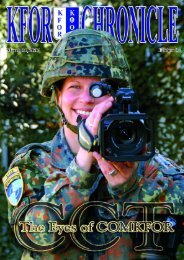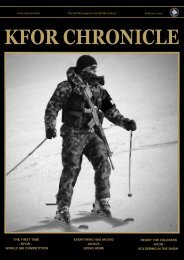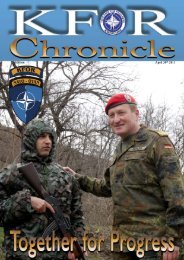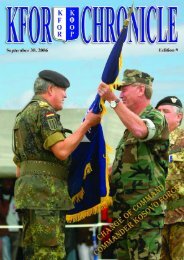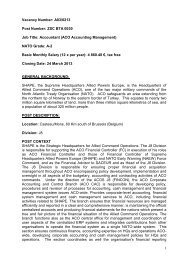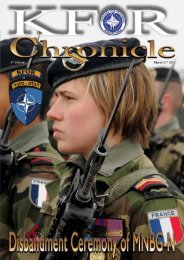January - ACO - NATO
January - ACO - NATO
January - ACO - NATO
- No tags were found...
Create successful ePaper yourself
Turn your PDF publications into a flip-book with our unique Google optimized e-Paper software.
Story by Lieutenant Colonel Jens Peder Nyrup, DanishArmyPhotos by Warrant Officer Torben Chistenser, DanishArmyAs we enter February 2011, an era ends for the Danisharmy. After eleven years of operations in KFOR, thelast contingent has been withdrawn from Kosovo. Thisalso marks the end of twenty years of presence in theBalkans; in Croatia, Bosnia & Herzegovina, Albaniaand former Yugoslav Republic of Macedonia(FYROM). From February, the Danish contingent willconsist of only a Force Protection Platoon in NovoSelo and five staff officers in KFOR HQ. Thiscontingent is provided by the Home Guard, which isnot part of the regular Army.The Danish engagement in Kosovo started in July1999 with the deployment of a Battle Group of around1,000 soldiers, the most powerful contingent theDanish Army had ever deployed abroad. The BattleGroup had two infantry companies, a tank squadron,heavy mortars, anti tank platoon, RECCE platoon andthe combat and combat service support, necessary tosustain operations independently. The Battle Groupwas deployed in the area west and northwest of thecity of Mitrovica in Multinational Brigade NorthAOR.Over the following ten years, twenty-one teams servedunder the Multinational Brigade North. The BattleGroup changed organisation and was reduced innumbers and units, but the Area of Operationsremained more or less the same – with smalladjustments.In <strong>January</strong> 2010, KFOR passed through Gate 1. TheMultinational Task Force North was transformed intoMultinational Battle Group North (MNBG N) and theDanish contingent reduced to a Company size unitplus a few additional assets within MNBG N. CampOlaf Rye – famous for DANCON Marches andSunday brunches – was closed and the DanishContingent moved to its present home in Novo Selo.Also the tasks of the Danish soldiers changed. Theinfantry company was now used throughout northernKosovo. Only the two Liaison & Monitoring Teamsremained, responsible for their “old areas” inSkenderai and Zubin Potok.More than 10,000 Danish soldiers served in Kosovo,one did not return alive. On 26 April 2003 LanceCorporal Susanne Lauritzen was killed in a roadtraffic accident, North West of Zvecan. On the spot,where she lost her life, her comrades raised amonument. The stone is now being sent back to herhome garrison in Denmark, leaving a small plaque12 KFOR Chronicle, <strong>January</strong> 2011



